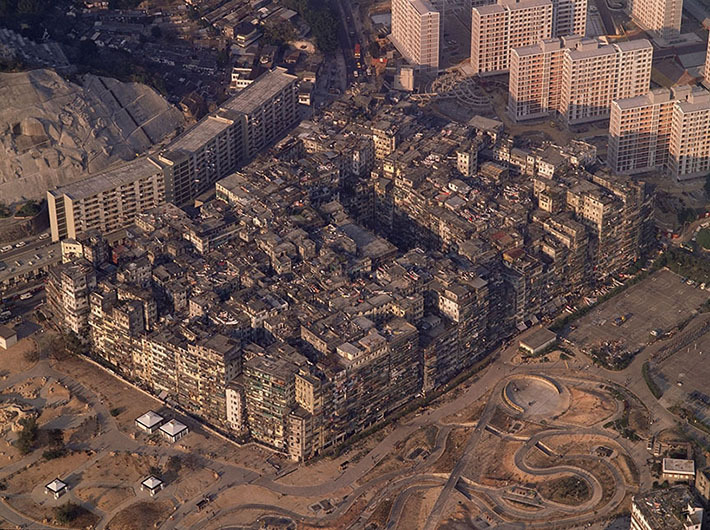So there's a lot of know-it-alls and people who think they know-it-all (Lukep) that claim Anarcho-Capitalism is the ideal way to establish a society without a State nor laws.
Are there any real life examples of Anarcho-Capitalism in action? Well nothing in real life is going to be exactly like what you see on paper, but there are indeed some examples of societies that practice many of the concepts of Anarcho-Capitalism.
Hong Kong is a place that has a government that more or less follows Chicago School concepts such as positive non intervention.
Full article on positive non intervention here:
http://en.wikipedia.org/wiki/Positive_non-interventionism
This economic policy is ultimately what continues to allow HK to remain the freest economy in the world when ranked by libertarian think tanks such as Heritage Foundation and Cato Institute.
But that doesn't come close to Anarcho-Capitalism. After all Hong Kong still had a society with a government and a legal system. However there was one tiny 2.6 hectare enclave called Kowloon Walled City where Hong Kong law did not exist and HK law enforcement mostly steered clear from. It existed due to this portion of land not being included in the Convention for the Extension of Hong Kong Territory of 1898 and thus not recognized as a part of Hong Kong nor China.
Kowloon Walled City had no official government and was considered a no mans land. Despite that, it became the most densely populated and ungoverned settlement on the planet complete with 300 buildings crammed into one city block built without the contribution of a single architect and with absolutely zero regulatory oversight.
The people who lived and worked within the walls of Kowloon Walled City did so without any health or employment regulations. All kinds of illegal businesses such as drug dens, gambling dens, unlicensed factories, and unlicensed dental clinics sprung up in the city. Although these businesses did not pay tax, they ultimately did have to pay protection money to the Triads who served as a de facto governing authority. Supporters of Anarcho-Capitalism claim that criminal elements would not turn into a governing authority, and that good people would chase them out, but Kowloon Walled City had demonstrated that the opposite is true.
Nevertheless, Kowloon Walled City was a mostly peaceful tightly knit community albeit cramped and unhygienic. As long as people doing a business or trade paid their protection money, they were fine.
Check out this eye opening documentary about the Kowloon Walled City and see for yourself.
Part 1:
[ame="http://www.youtube.com/watch?v=Lby9P3ms11w"]Kowloon Walled City documentary (Part 1/4) + english subtitles - YouTube[/ame]
Part 2:
[ame="http://www.youtube.com/watch?v=xYXPRSRIAPQ"]Kowloon Walled City documentary (Part 2/4) + english subtitles - YouTube[/ame]
Part 3:
[ame="http://www.youtube.com/watch?v=iMlbr-zqnQQ"]Kowloon Walled City documentary (Part 3/4) + english subtitles - YouTube[/ame]
Part 4:
[ame="http://www.youtube.com/watch?v=LGhvEcbAnxc"]Kowloon Walled City documentary (Part 4/4) + english subtitles - YouTube[/ame]
and check out this Kickstarter:
https://www.kickstarter.com/projects/1060791749/city-of-darkness-revisited
To conclude, Kowloon Walled City is a fascinating example of the closest thing out there to real Anarcho-Capitalism besides Somalia. Is it however the ideal society that we should strive for?
Kowloon Walled City was major contribution to Hong Kong's massive economic growth in the 80s and 90s, thanks to all of the cheap and unregulated manufacturing that was done within the enclave. It helped transform Hong Kong from a developing economy to a developed one.
Unfortunately life in Kowloon Walled City was hard, and the unregulated environment posed health and safety concerns that can not be brushed away. People there worked hard and died young. It was demolished in 1994 and the area is now called Kowloon City Park. It is currently under the jurisdiction of Hong Kong law.
Echoes of Kowloon Walled City still exist in HK due to its legacy of positive non interventionism. In the rural New Territories for example, there is almost no government oversight much like in Kowloon Walled City. Legally recognized male villagers are allowed to build a 3 story house, and many bend the rules by adding additional floors and other illegal structures because government bureaucrats almost never go there. When they do, their enforcement power is severely limited due to the influence of the Heung Yee Kuk (Rural Committee). The Heung Yee Kuk is a private entity that serves as the de facto governing power in the rural areas of the New Territories. It sides with the villagers during land and property disputes, and when it does the government can't do much about enforcing the law because the Kuk won't let them. So rather than create a conflict, the government just avoids confronting the Kuk.
The rural areas of HK aren't the only place the government keeps a hands off regulatory policy. Sub divided flats for low income people who either don't qualify for public housing or are still in the queue waiting for a public house are another example of something the HK government turns a blind eye to.
Each flat is a cramped 120 to 150 square feet and is the closest modern example we have to the cramped conditions of flats in Kowloon Walled City. The government doesn't want to regulate these sub divided flats, because if it declares them illegal and evicts everyone there will be a housing crisis. So instead we have the status quo.
I hope everyone enjoyed reading my OP. This is officially my third ever thread on WF that I've made. Normally I prefer to contribute to other people's threads rather than making my own. I hope other WFers will contribute to my thread regardless of where they stand on the political spectrum. I am sure we can have a very interesting discussion here.
Are there any real life examples of Anarcho-Capitalism in action? Well nothing in real life is going to be exactly like what you see on paper, but there are indeed some examples of societies that practice many of the concepts of Anarcho-Capitalism.
Hong Kong is a place that has a government that more or less follows Chicago School concepts such as positive non intervention.
Full article on positive non intervention here:
http://en.wikipedia.org/wiki/Positive_non-interventionism
Positive non-interventionism is the economic policy of Hong Kong; this policy can be traced back to the time when Hong Kong was under British rule. It was first officially implemented in 1971 by John Cowperthwaite, who observed that the economy was doing well in the absence of government intervention but it was important to create the regulatory and physical infrastructure to facilitate market-based decision making. The policy was continued by subsequent Financial Secretaries, including Sir Philip Haddon-Cave. Economist Milton Friedman has cited it as a fairly comprehensive implementation of laissez-faire policy, although Haddon-Cave has stated that the description of Hong Kong as a laissez-faire society was "frequent but inadequate".[1]
This economic policy is ultimately what continues to allow HK to remain the freest economy in the world when ranked by libertarian think tanks such as Heritage Foundation and Cato Institute.
But that doesn't come close to Anarcho-Capitalism. After all Hong Kong still had a society with a government and a legal system. However there was one tiny 2.6 hectare enclave called Kowloon Walled City where Hong Kong law did not exist and HK law enforcement mostly steered clear from. It existed due to this portion of land not being included in the Convention for the Extension of Hong Kong Territory of 1898 and thus not recognized as a part of Hong Kong nor China.
Kowloon Walled City had no official government and was considered a no mans land. Despite that, it became the most densely populated and ungoverned settlement on the planet complete with 300 buildings crammed into one city block built without the contribution of a single architect and with absolutely zero regulatory oversight.
The people who lived and worked within the walls of Kowloon Walled City did so without any health or employment regulations. All kinds of illegal businesses such as drug dens, gambling dens, unlicensed factories, and unlicensed dental clinics sprung up in the city. Although these businesses did not pay tax, they ultimately did have to pay protection money to the Triads who served as a de facto governing authority. Supporters of Anarcho-Capitalism claim that criminal elements would not turn into a governing authority, and that good people would chase them out, but Kowloon Walled City had demonstrated that the opposite is true.
Nevertheless, Kowloon Walled City was a mostly peaceful tightly knit community albeit cramped and unhygienic. As long as people doing a business or trade paid their protection money, they were fine.
Check out this eye opening documentary about the Kowloon Walled City and see for yourself.
Part 1:
[ame="http://www.youtube.com/watch?v=Lby9P3ms11w"]Kowloon Walled City documentary (Part 1/4) + english subtitles - YouTube[/ame]
Part 2:
[ame="http://www.youtube.com/watch?v=xYXPRSRIAPQ"]Kowloon Walled City documentary (Part 2/4) + english subtitles - YouTube[/ame]
Part 3:
[ame="http://www.youtube.com/watch?v=iMlbr-zqnQQ"]Kowloon Walled City documentary (Part 3/4) + english subtitles - YouTube[/ame]
Part 4:
[ame="http://www.youtube.com/watch?v=LGhvEcbAnxc"]Kowloon Walled City documentary (Part 4/4) + english subtitles - YouTube[/ame]
and check out this Kickstarter:
https://www.kickstarter.com/projects/1060791749/city-of-darkness-revisited
To conclude, Kowloon Walled City is a fascinating example of the closest thing out there to real Anarcho-Capitalism besides Somalia. Is it however the ideal society that we should strive for?
Kowloon Walled City was major contribution to Hong Kong's massive economic growth in the 80s and 90s, thanks to all of the cheap and unregulated manufacturing that was done within the enclave. It helped transform Hong Kong from a developing economy to a developed one.
Unfortunately life in Kowloon Walled City was hard, and the unregulated environment posed health and safety concerns that can not be brushed away. People there worked hard and died young. It was demolished in 1994 and the area is now called Kowloon City Park. It is currently under the jurisdiction of Hong Kong law.
Echoes of Kowloon Walled City still exist in HK due to its legacy of positive non interventionism. In the rural New Territories for example, there is almost no government oversight much like in Kowloon Walled City. Legally recognized male villagers are allowed to build a 3 story house, and many bend the rules by adding additional floors and other illegal structures because government bureaucrats almost never go there. When they do, their enforcement power is severely limited due to the influence of the Heung Yee Kuk (Rural Committee). The Heung Yee Kuk is a private entity that serves as the de facto governing power in the rural areas of the New Territories. It sides with the villagers during land and property disputes, and when it does the government can't do much about enforcing the law because the Kuk won't let them. So rather than create a conflict, the government just avoids confronting the Kuk.
The rural areas of HK aren't the only place the government keeps a hands off regulatory policy. Sub divided flats for low income people who either don't qualify for public housing or are still in the queue waiting for a public house are another example of something the HK government turns a blind eye to.
Each flat is a cramped 120 to 150 square feet and is the closest modern example we have to the cramped conditions of flats in Kowloon Walled City. The government doesn't want to regulate these sub divided flats, because if it declares them illegal and evicts everyone there will be a housing crisis. So instead we have the status quo.
I hope everyone enjoyed reading my OP. This is officially my third ever thread on WF that I've made. Normally I prefer to contribute to other people's threads rather than making my own. I hope other WFers will contribute to my thread regardless of where they stand on the political spectrum. I am sure we can have a very interesting discussion here.


